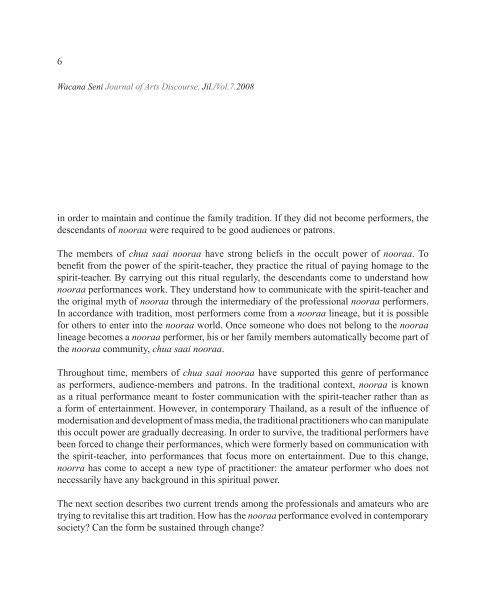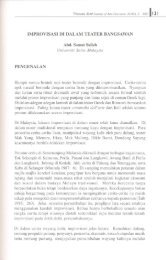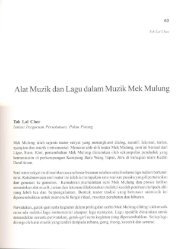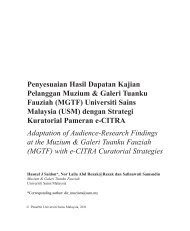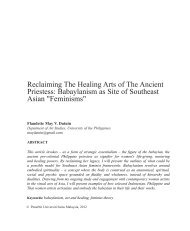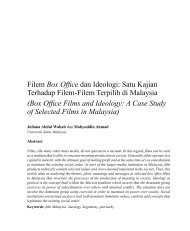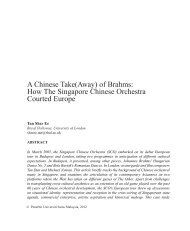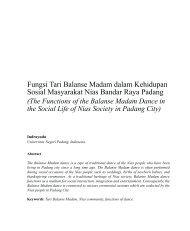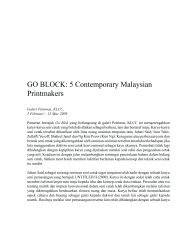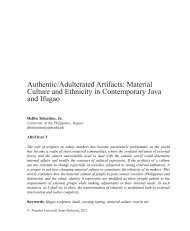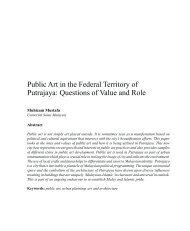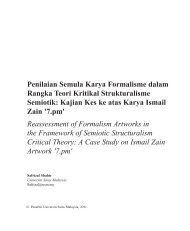Preservation of Traditional Art: The Case of the ... - Wacana Seni
Preservation of Traditional Art: The Case of the ... - Wacana Seni
Preservation of Traditional Art: The Case of the ... - Wacana Seni
Create successful ePaper yourself
Turn your PDF publications into a flip-book with our unique Google optimized e-Paper software.
6<strong>Wacana</strong> <strong>Seni</strong> Journal <strong>of</strong> <strong>Art</strong>s Discourse. Jil./Vol.7.2008in order to maintain and continue <strong>the</strong> family tradition. If <strong>the</strong>y did not become performers, <strong>the</strong>descendants <strong>of</strong> nooraa were required to be good audiences or patrons.<strong>The</strong> members <strong>of</strong> chua saai nooraa have strong beliefs in <strong>the</strong> occult power <strong>of</strong> nooraa. Tobenefit from <strong>the</strong> power <strong>of</strong> <strong>the</strong> spirit-teacher, <strong>the</strong>y practice <strong>the</strong> ritual <strong>of</strong> paying homage to <strong>the</strong>spirit-teacher. By carrying out this ritual regularly, <strong>the</strong> descendants come to understand hownooraa performances work. <strong>The</strong>y understand how to communicate with <strong>the</strong> spirit-teacher and<strong>the</strong> original myth <strong>of</strong> nooraa through <strong>the</strong> intermediary <strong>of</strong> <strong>the</strong> pr<strong>of</strong>essional nooraa performers.In accordance with tradition, most performers come from a nooraa lineage, but it is possiblefor o<strong>the</strong>rs to enter into <strong>the</strong> nooraa world. Once someone who does not belong to <strong>the</strong> nooraalineage becomes a nooraa performer, his or her family members automatically become part <strong>of</strong><strong>the</strong> nooraa community, chua saai nooraa.Throughout time, members <strong>of</strong> chua saai nooraa have supported this genre <strong>of</strong> performanceas performers, audience-members and patrons. In <strong>the</strong> traditional context, nooraa is knownas a ritual performance meant to foster communication with <strong>the</strong> spirit-teacher ra<strong>the</strong>r than asa form <strong>of</strong> entertainment. However, in contemporary Thailand, as a result <strong>of</strong> <strong>the</strong> influence <strong>of</strong>modernisation and development <strong>of</strong> mass media, <strong>the</strong> traditional practitioners who can manipulatethis occult power are gradually decreasing. In order to survive, <strong>the</strong> traditional performers havebeen forced to change <strong>the</strong>ir performances, which were formerly based on communication with<strong>the</strong> spirit-teacher, into performances that focus more on entertainment. Due to this change,noorra has come to accept a new type <strong>of</strong> practitioner: <strong>the</strong> amateur performer who does notnecessarily have any background in this spiritual power.<strong>The</strong> next section describes two current trends among <strong>the</strong> pr<strong>of</strong>essionals and amateurs who aretrying to revitalise this art tradition. How has <strong>the</strong> nooraa performance evolved in contemporarysociety? Can <strong>the</strong> form be sustained through change?


